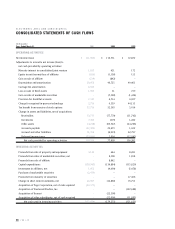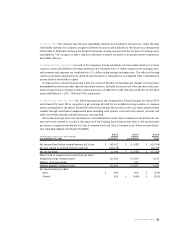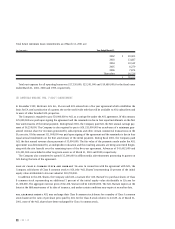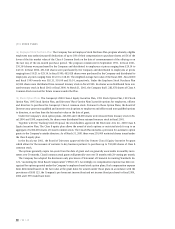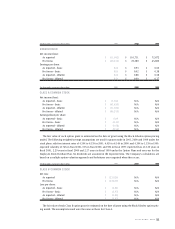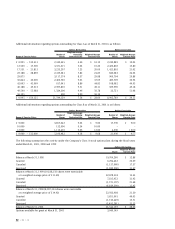Electronic Arts 2001 Annual Report Download - page 47
Download and view the complete annual report
Please find page 47 of the 2001 Electronic Arts annual report below. You can navigate through the pages in the report by either clicking on the pages listed below, or by using the keyword search tool below to find specific information within the annual report.
ELECTRONIC ARTS
45
(p) Impact of Recently Issued Accounting Standards
In June 1998, the Financial Accounting Standards Board
(“FASB”) issued Statement of Financial Accounting Standards No. 133 (“SFAS 133”) “Accounting for Derivative
Instruments and Hedging Activities”, as amended by SFAS 137 “Accounting for Derivative Instruments and Hedging
Activities - Deferral of the Effective Date of FASB Statement No. 133 – an Amendment of FASB Statement No. 133” and
SFAS 138 “Accounting for Certain Derivative Instruments and Certain Hedging Activities – an Amendment of FASB
Statement No. 133” which establishes accounting and reporting standards for derivative instruments and hedging
activities. The terms of SFAS 133 and SFAS 138 are effective as of the beginning of the first quarter of the fiscal
year beginning after June 15, 2000. The Company is determining the effect of SFAS 133, 137 and 138 on its finan-
cial statements.
In April 2001, the Emerging Issues Task Force issued No. 00-25 (“EITF 00-25”), “Accounting for Consideration
from a Vendor to a Retailer in Connection with the Purchase or Promotion of the Vendor’s Products”, which states
that consideration from the vendor to a reseller of the vendor’s products is presumed to be a reduction of the sell-
ing prices of the vendor’s products and, therefore, should be characterized as a reduction of revenue when recog-
nized in the vendor’s income statement. That presumption is overcome and the consideration can be categorized
as a cost incurred if, and to the extent that, a benefit is or will be received from the recipient of the consideration.
That benefit must meet certain conditions described in EITF 00-25. The consensus should be applied no later than
in annual or interim financial statements for periods beginning after December 15, 2001. The Company is current-
ly evaluating the impact of this consensus on its Statement of Operations.
(q) Use of Estimates
The preparation of financial statements in conformity with generally accepted accounting
principles requires management to make estimates and assumptions that affect the reported amounts of assets
and liabilities and disclosures of contingent assets and liabilities at the date of the financial statements and the
reported amounts of revenues and expenses during the reporting period. Such estimates include provisions for
doubtful accounts, sales returns and allowances, warranty provisions, and estimates regarding the recoverability
of prepaid royalty advances and inventories. Actual results could differ from those estimates.
(r) Reclassifications
Certain amounts have been reclassified to conform to fiscal 2001 presentation.
(s) Long-Lived Assets
The Company evaluates long-lived assets and certain identifiable intangibles for impairment
whenever events or changes in circumstances indicate that the carrying amount of an asset may not be recover-
able. Recoverability of assets is measured by a comparison of the carrying amount of an asset to future undis-
counted net cash flows expected to be generated by the asset. If such assets are considered to be impaired, the
impairment to be recognized is measured by the amount by which the carrying amount of the asset exceeds its
fair value.
(2) TRACKING STOCK
On March 22, 2000, the stockholders of Electronic Arts authorized the issuance of a new series of common stock,
designated as Class B common stock (“Tracking Stock”). The Tracking Stock is intended to reflect the performance
of Electronic Arts’ online and e-Commerce division (“EA.com”). As a result of the approval of the Tracking Stock
Proposal, Electronic Arts’ existing common stock has been re-classified as Class A common stock (“Class A Stock”)
and that stock reflects the performance of Electronic Arts’ other businesses (“EA Core”).





